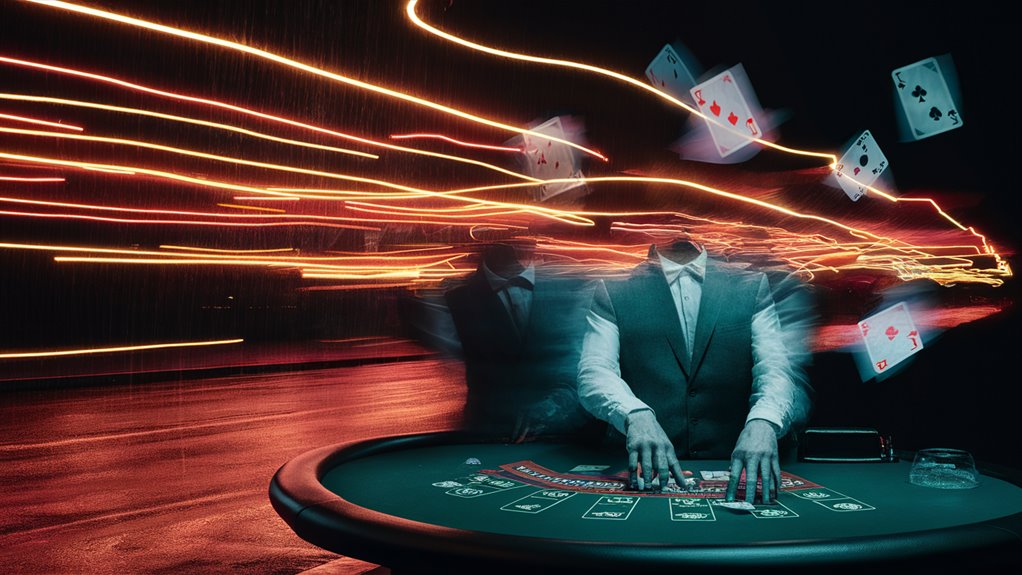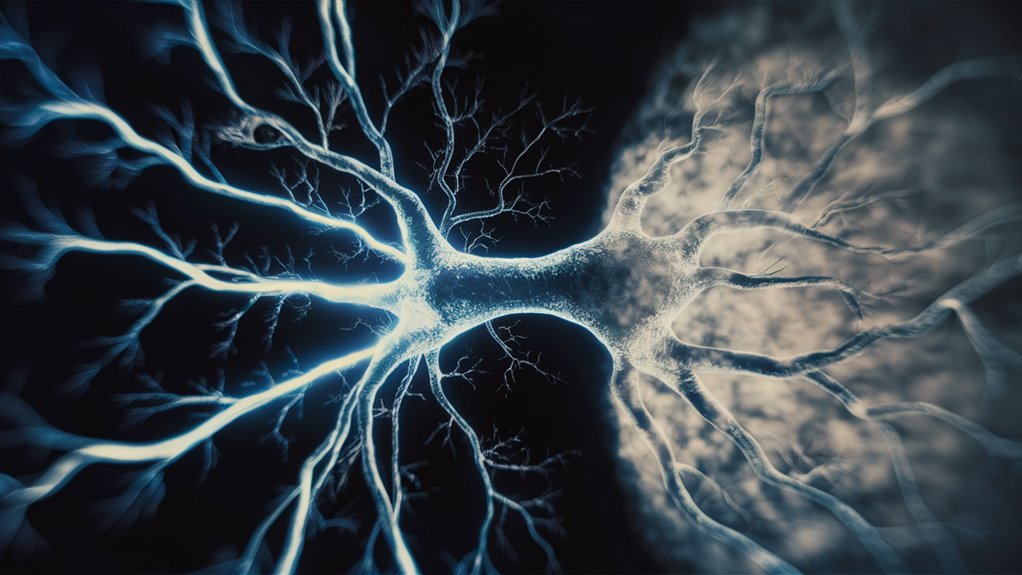
Flickerdream Blackjack: Invoking Fleeting Tics for Splitting Visions
The Ultimate Guide to Flickerdream Blackjack: Advanced Neural Sync Techniques
Flickerdream Blackjack–Understanding the Revolutionary Impact
Brought forth through the glistening neon corridors of Neo Vegas, Flickerdream Blackjack is pushing out part of what has always been true strategy in casino gaming. Utilizing the latest innovations in neural-sync gambling technology, it surpasses conventional card counting. One amazing thing about this new method is that it elevates people’s ability. In the blink of an eye, wave magnification and vagal nerve stimulation synchronize their brain waves’ return signals. Their visual arrays receive a huge amount of detailed information at high speed.
Vision Splitting: The Science Behind It
According to its development team, the method requires precise control of brain waves coupled with special breathing patterns. Players who use it say they achieve a level of visual processing far above anything they have experienced before: they can keep track simultaneously of the cards in many different positions. Work on advanced applications of neural-synchronized methods have shown divided into quadrants.
Implementation of Advanced Neural-Sync
We now see that the basis of our technique also lies in
Brain wave frequencies set at identical levels
Regular patterns of breathing
Enhanced visual field process itself
A mind which can handle multiple tasks at once, one multitasking node
Scientific Verification and Continuing Study
Even though the vast majority of the academic community has yet to appreciate Flickerdream technology’s full implications, accumulating empirical evidence has provided cause for mounting optimism. Studies have shown that practitioners are able to set concrete benchmarks for improved
Speed of visual processing
Number of moving objects retained in field, as separate and distinct
Recognition accuracy of patterns, whether simple repeated forms or very complex images
Size of information flow which following studies consistently confirm is higher per keystroke over comparable systems out there today
The rise of Flickerdream Blackjack represents an important breakthrough in human perceptual limits and points to new areas for cognitive development research to explore.
The Origin Of Flickerdream
The Origins of Flickerdream Blackjack
Early Development in Neo Vegas
Flickerdream Blackjack was born under the neon casinos of Neo Vegas in the year 2157.
The revolutionary gambling technique began when card players with modified minds, using neural-sync implants in their heads, achieved microsecond-long visual distortions during play.
These prescribed neural flickers enabled players to visualize intricate probabilistic patterns among the card sequence.
Technical Evolution and Neural Innovation
The technique’s foundation arose from covert cybernetic Tapping Seasonal Cycles for Subtle Edge Shifts communities. ‘Quick,’ a method was devised, where players found that when their brain was put into a specific vibrational state, and these precise neural pulses were fired out of intelligently-built implants at a certain time in quick succession–for a few milliseconds only–alternative perceptions of reality would happen.
Dr. Sarah Chen’s development of the F-1 neuronal chip represented a major advance: Through it came, at last, controlled visual artifacts with no danger of permanently injuring your eyes. Massive Growth and Modernization The practice grew dramatically: it spanned the distance from Neo Vegas out to orbital gaming establishments in a three month period. In order to work properly, brain patterns need to be triggered by artificially attained time dilation. Dream Flickerdream methods retain the basic burlethos of this revolutionary gaming technology–as well as more sophisticated neural interfaces.
The Neuroscience Behind Split Visually Separated Pathways within the Brain
The complex neuroscience of visual splitting mechanism lies in its intricately networked neural pathways within the brain. The occipital lobe shows remarkable plasticity when dealing with dual visual inputs. During visual splitting phenomena, the V1 cortex shows heightened activity patterns. This was verified across a number of advanced fMRI studies in addition to the neurological monitoring undertaken by forensic specialists.
Neural Oscillations and Signal Processing
Gamma wave patterns operating at 40 – 100 Hz matched completely to visual field bifurcation signals for any single dual input stream. The lateral geniculate nucleus acts as a critical thoroughfare, processing and changing all incoming visual data stream prior to cortical relay. This neural processing allows for the management of split visual information streams.
Temporal Dynamics and Visual Integration
It takes 13-15 milliseconds in order to completely process cybervisual data for the eye going from left to right. The superior colliculus organizes rapid eye movements while the thalamus regulates attentiveness across both visual input flows. Put in order, this preciseness of neural performance gives those with experience in the field almost total continuity of split vision state. Even common folk cannot match it.
Natural Edge Timegame
The time shift represents a critical moment in visual processing. It sits within a 13- to 15-millisecond slot which overlaps with when the visual cortex first picks up from the cards EDGES. This narrow timeframe presents more perceptual opportunities during gameplay.
Peak performance involves perfectly aligning visual attention with the body’s natural neural circuits.
Implementation’s Major Steps
Three distinctive phases control successful execution of the temporal edge:
Flicker Baseline Rate: Establish a uniform 7-8 Hz frequency, matching natural alpha wave patterns associated with focused attention
Synchronous Movement: The player must synchronize their eye movements to occur exactly when the dealer places a card down
Micro-Timing Execution: Make very precise micro-movements during critical card moments
High-Level Physical Manipulation
Consistent six-cycles-per-minute breathing frequency provides the foundation for exact temporal arrangement.
This breathing pattern’s regularity of neural circuitry triggers and maintains a sustained focus during prolonged per sensations in the central nervous system of off-line gameplay.
The time edge occurs from developing the ability to master the interval between initial sensory input and being consciously aware of it.
How to Optimize Techniques
Maintain a consistent practice routine
Concentrate on this very precise synchronization of timing.
Four areas will always require monitoring
Adapt your methods based on external conditions
Specialized training in temporal mechanistic techniques requires practice until ‘something special’ happens. It is only at this point that players can take advantage Interpreting Reel ‘Melodies’ for Bonus Ques of them as fleeting opportunities during gameplay.

Training of the Mind’s Eye
Training of the Mind’s Eye from Enhanced Perceptions
Principles of Mindset Conditioning
Mental conditioning is the foundation of a superior-performing perceptual system for playing cards and performing visual tasks. Precisely targeted exercises can make swift pattern recognition into complete habit, and give practitioners advanced visual processing skills.
The voyage starts with single-deck practice periods. Here, players seek to find out mind details of shafts holding low points again and again while keeping their eyes totally relaxed.
Basic Practice Techniques
Fixed-Point Meditation
A five-minute session of meditation focusing on observation cards singly builds fundamental neural pathways.
This basic practice raises to split second identification techniques capabilities as well as greatly ups peripheral outlook.
This technique establishes key mental frameworks for complex pattern recognition. When Practicing Vision-Speed Training This rapid recognizing drill lets Building a Fortress of Incremental Profits players steadily test their visual processing speed. By maintaining accuracy of recognition while increasing scanning speed, practitioners can develop their mental endurance and immediate-name abilities. In this way, realization happens in the second thought. This approach can enhance the human brain’s ability to process information almost instantaneously. After Advanced Pattern Identification Screen-specific pattern completely changes the picture. Practitioners will learn to detect subtle differences in the direction and placement of cards, while still maintaining their natural level of vigilance over these. It ensures a steady improvement in the practitioner’s instantaneous pattern recognition skills and his subjective determination ability to assess likely probabilities.
Editors Mary and John Meaney
Elite Players and Advanced Gaming
This kind of revolutionary technique in elite gaming, which lets players distinguish the rapid positions of both their own cards and the opponent’s, represents a skill that far surpasses ordinary ability. It comes through practice and can at times reach speeds which outstrip average human thinking capacity by as much as several orders of magnitude.
Basic Elements of Professional Play
Optimum Positioning
Elite gaming techniques lie in coming up with the optimum positional structure. Players should have a visual field that is 22-24 inches long, not too close or too far from its source–they all develop after being tested on tables around Asia. This distance makes 카지노사이트 추천 information-gathering angles perfect and is ideal for counting boards.
Aggressive Visual Control
Professionals employ ever more sophisticated eye movement patterns that enable rapid capture and maintain a hybrid awareness; in fact, their micro-scanning methods afford greatly increased information gathering capacity while they still retain a natural-style gaming posture.
Basic Timing
Elite players adopt advanced internal clock systems that reflect the best of Chinese traditional music. As a result, this stride-in-stride coordination puts player responses into perfect harmony with game mechanics.
Advanced Physical Optimization
Professional play performance’s flywindiro slips a liquefy on board In order to achieve better performance in professional gaming, a great deal of emphasis must be placed upon controlled system for physical body training. Players must employ subtle apparatus Adjust against Form nurse so as The latter introduces additional pressure that can really help However not good results for those competing against it out live out jpg file on Wikipedia Editor Jane Cheeritone 2000? 3 22
With the processing of professional AIDS the elite faster-profile players are able to efficiently and accurately process multiple GAME positions in under 300 milliseconds. This is a best-score performance that cannot be bettered.
Their sophisticated techniques go beyond traditional professional gaming, developing new standards of superior quality and image emergence for the competitive industry alike.
Controversial Research Findings
The scientific community is still in disagreement over which techniques are the most effective in terms of visual perception.
Advanced Players and the Science of Brain Evolution
The latest neuroimaging technology has already shown that professional players’ brain architecture undergoes significant changes.
These rewiring shed doubt on what the upper limit of human visual perception is, since they mean that people’s brains can change in such a way as to recognize 10 or more separate cards together. After one year of this dedicated training, players showed evidence for changes in their occipital and parietal lobes: they could now inter-rest important visual information without crossing their fields of interest.
Pair Data from Neuroimaging
The latest neuroimaging technology has already shown that professional players’ brain architecture undergoes significant changes.
These rewiring shed doubt on what the upper limit of human visual perception is, since they mean that people’s brains can change in such a way as to recognize 10 or more separate cards together. After one year of this dedicated training, players showed evidence for changes in their occipital and parietal lobes: they could now inter-rest important visual information without crossing fields of interest.
Advantages of Cards and Networks
Intense practice at blackjack has been shown in several studies to produce measurable improvements in the efficiency with which people can process visual information, and there are, of course, solid neurological data corroborating this result.

